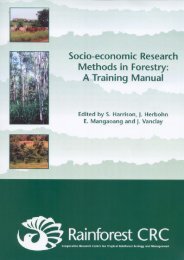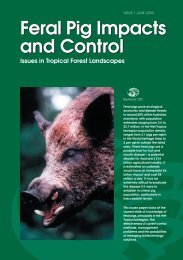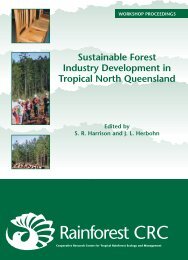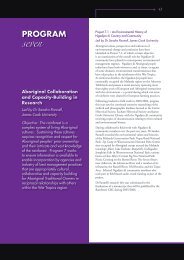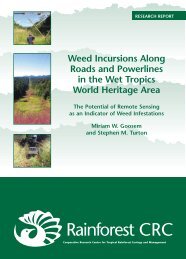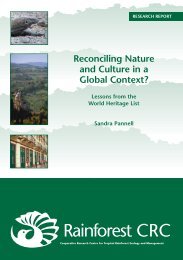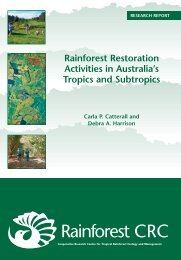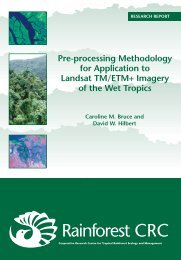S<strong>and</strong>ra Pannellprovide research <strong>and</strong> advice to the government agencies <strong>and</strong> statutory bodies responsiblefor ‘manag<strong>in</strong>g’ the two World Heritage areas. In the world of ‘research providers’ <strong>and</strong> ‘endusers’, nature is variously depicted as a ‘public environmental asset’, def<strong>in</strong>ed as ‘ecosystemgoods <strong>and</strong> services’, or spoken about <strong>in</strong> terms of ‘biodiversity’. Us<strong>in</strong>g the current hybridlexicon result<strong>in</strong>g from the marriage of economic rationalism <strong>and</strong> <strong>in</strong>dustry-responsive science,scientists speak of this nature as devoid of humans <strong>and</strong> clearly separated from culture (seeDwyer 1996). <strong>Nature</strong> <strong>and</strong> culture also constitute the key conceptual components <strong>in</strong> the multimilliondollar regional tourism economy, where <strong>in</strong>dustry activities <strong>in</strong> the two world heritageareas are depicted as ‘nature-based tourism’ by the peak bodies, the Alliance for Susta<strong>in</strong>ableTourism <strong>and</strong> the Queensl<strong>and</strong> Tourism Industry Corporation. Contrary to Dwyer’s observationthat “Westerners know it [nature] is an <strong>in</strong>vention, an artefact” (1996: 157), <strong>in</strong> NorthQueensl<strong>and</strong> nature is regarded as hav<strong>in</strong>g a rock-solid reality.Given the pervasiveness of the nature-culture discourse, <strong>and</strong> its varied use by bothAborig<strong>in</strong>al <strong>and</strong> Anglo-Australians as a l<strong>in</strong>gua franca <strong>in</strong> regional discussions <strong>and</strong> debates, it isdifficult to see a way out of, or around, the paradigm, at least <strong>in</strong> Australia that is. Indeed, ifthe efforts of the Traditional Owners of the Wet Tropics <strong>in</strong> lobby<strong>in</strong>g the Government ofAustralia to proceed with the renom<strong>in</strong>ation of the World Heritage area are anyth<strong>in</strong>g to go by,it would appear that some sectors of the regional community don’t see the nature-cultureidea as such an obstacle to their aspirations. In the f<strong>in</strong>al section of this report, I brieflyexplore what it might mean to be def<strong>in</strong>ed as part of a ‘cultural l<strong>and</strong>scape’ under the auspicesof the World Heritage Convention.CAUGHT IN CULTURE: MORE LESSONS FROM THE WORLDHERITAGE LISTIn Australia, Uluru Kata Tjuta National Park, listed as an ‘associative cultural l<strong>and</strong>scape’, isoften cited as an exemplary model of the possibilities <strong>and</strong> practicalities of manag<strong>in</strong>g a ‘liv<strong>in</strong>gcultural l<strong>and</strong>scape’. As Lennon po<strong>in</strong>ts out, however, “[W]orld Heritage associative culturall<strong>and</strong>scapes have special needs for strategies <strong>and</strong> actions to ma<strong>in</strong>ta<strong>in</strong> the traditionalassociations which give the place its outst<strong>and</strong><strong>in</strong>g universal values” (2003: 123). Ma<strong>in</strong>ta<strong>in</strong><strong>in</strong>gthese associative values thus entails ma<strong>in</strong>ta<strong>in</strong><strong>in</strong>g the cultural associations <strong>and</strong> cultural wellbe<strong>in</strong>gof the group(s) whose values have been <strong>in</strong>scribed on the World Heritage List. Failureto recognise the very different management requirements of associative cultural l<strong>and</strong>scapesmay result <strong>in</strong> the placement of the l<strong>and</strong>scape on the World Heritage <strong>in</strong> Danger List, or thereclassification of the property as a relict l<strong>and</strong>scape (loc. cit.). Perhaps, more disturb<strong>in</strong>g thanthese scenarios of heritage demotion is the fate of those groups or people who, byassociation, are similarly classified as ‘relict’ or ‘<strong>in</strong> danger’.While this reference to the bureaucratic reshuffl<strong>in</strong>g of World Heritage properties <strong>and</strong>categories appears <strong>in</strong>nocent enough, reclassification opens up new spaces for the oldpractices of social eng<strong>in</strong>eer<strong>in</strong>g. For example, concern about the <strong>in</strong>cidence of petrol sniff<strong>in</strong>gamong young Aborig<strong>in</strong>al people, <strong>and</strong> the possible negative impact of this activity on theviability of the World Heritage-listed values of Uluru Kata Tjuta National Park derived fromAnangu ‘oral history’ <strong>and</strong> ‘traditional knowledge’, has led to the development of a number oftargeted youth education programs to address this ‘problem’. In keep<strong>in</strong>g the associative <strong>and</strong>cont<strong>in</strong>u<strong>in</strong>g values of this World Heritage property “strong”, Anangu are “assisted” by ParksAustralia, the Australian Government’s federal environmental agency (Calma <strong>and</strong> Liddle2003). Given its history of European colonisation, government control, <strong>and</strong> the 1985 leasebackarrangement to the Australian National Parks <strong>and</strong> Wildlife Service, <strong>in</strong> Uluru Kata TjutaNational Park, like so many other World Heritage properties, it is clear that the localcommunity does not set its own agenda. This po<strong>in</strong>t was recently brought home to theAborig<strong>in</strong>al Traditional Owners <strong>and</strong> residents of the Park. As reported <strong>in</strong> the national media,the closure of the Park <strong>in</strong> May 2001 for ‘sorry bus<strong>in</strong>ess’ (i.e. the death of an Aborig<strong>in</strong>al elder)74
<strong>Reconcil<strong>in</strong>g</strong> <strong>Nature</strong> <strong>and</strong> <strong>Culture</strong> <strong>in</strong> a <strong>Global</strong> <strong>Context</strong>?Lessons from the World Heritage List‘ignited a row’ that <strong>in</strong>volved national politicians, the Northern Territory Government, local <strong>and</strong><strong>in</strong>ternational tourism operators, <strong>and</strong> regional Aborig<strong>in</strong>al organisations. The 2001 closurehighlighted the conflict that exists between satisfy<strong>in</strong>g the dem<strong>and</strong>s of a multi-million dollartourism <strong>in</strong>dustry <strong>and</strong> ma<strong>in</strong>ta<strong>in</strong><strong>in</strong>g the listed Indigenous cultural values of the National Park.The 2001 closure of the Park, together with previous closures for ceremonial ‘ bus<strong>in</strong>ess’,alerts us to the fact that some cultural values <strong>and</strong> activities are often seen as unacceptableor un<strong>in</strong>telligible to a wider audience 68 . It is also apparent here that not all forms of culture arecompatible with the World Heritage ideal <strong>and</strong> management of culture, <strong>in</strong> the same way thatsome forms of nature don’t easily fit with<strong>in</strong> the def<strong>in</strong>ition of outst<strong>and</strong><strong>in</strong>g natural propertiesunder the Convention. In Uluru Kata Tjuta National Park, for the 200,000 visitors each year,cultural heritage is a performance consumed by way of ‘guided bush tucker tours’, ‘sacredsite walks’ or multi-media presentations at the Park’s ‘cultural centre’. For Anangu liv<strong>in</strong>g <strong>in</strong>the community of Mutijulu, located with<strong>in</strong> the National Park but off-limits to Park visitors,these highly orchestrated <strong>and</strong> public forms of heritage performance are not a part of whatpasses as culture for them on a day-to-day basis (pers. com. Daniel Vachon).For Indigenous people <strong>and</strong> m<strong>in</strong>ority groups, World Heritage list<strong>in</strong>g of their traditional estatesas a cultural l<strong>and</strong>scape raises serious issues about the relationship between local autonomy<strong>and</strong> global <strong>in</strong>tervention. As the example of Uluru Kata Tjuta National Park illustrates, forsome groups <strong>and</strong> peoples ma<strong>in</strong>ta<strong>in</strong><strong>in</strong>g World Heritage-listed l<strong>and</strong>scape values may <strong>in</strong>volvecreat<strong>in</strong>g new opportunities for the transmission of traditional skills <strong>and</strong> knowledge orrevitalis<strong>in</strong>g customary cultural activities. In either situation, effective management of anassociative cultural l<strong>and</strong>scape will need to address those social problems <strong>and</strong> economicpressures, which impact upon the cultural viability of the group. This issue of culturalviability, accentuated by the grow<strong>in</strong>g realisation that the way of life of many Indigenouspeople is “now under severe threat”, begs the question as to whether “‘preserv<strong>in</strong>g’ small,essentially non-Westernised Indigenous populations <strong>in</strong> their ‘natural’ habitats is the properbus<strong>in</strong>ess of those implement<strong>in</strong>g the World Heritage Convention” (Fowler 2003: 56). This is apert<strong>in</strong>ent question, particularly given the historical fact that many of the state parties to theConvention have woefully neglected their fiduciary duty to their Indigenous citizens. Thisquestion also highlights the fact that ultimately the protection of cultural l<strong>and</strong>scapes, heritage<strong>and</strong> values pivots upon the susta<strong>in</strong>able <strong>in</strong>volvement of, <strong>and</strong> support for, those groups <strong>and</strong>communities who are the traditional custodians of the cultural values expressed <strong>in</strong> thel<strong>and</strong>scape. With this acknowledgment comes the realisation that the production <strong>and</strong>protection of heritage, whether natural or cultural, is a highly politicised process that oftenhas very stultify<strong>in</strong>g effects.All too often under the auspices of the World Heritage Convention, cultural l<strong>and</strong>scapes <strong>and</strong>natural properties are depicted as liv<strong>in</strong>g ethnographic displays or zoological exhibits,disturb<strong>in</strong>gly rem<strong>in</strong>iscent of n<strong>in</strong>eteenth-century museological traditions. The many cultural68 In an <strong>in</strong>terest<strong>in</strong>g twist to the issue of <strong>in</strong>telligibility, the Federal Court of Australia found <strong>in</strong> March 2006that a group of Aborig<strong>in</strong>al Native Title Applicants, many of whom were identified <strong>in</strong> the 1979 Uluru(Ayers Rock) National Park <strong>and</strong> Lake Amadeus / Luritja L<strong>and</strong> Claim under the Aborig<strong>in</strong>al L<strong>and</strong>Rights (Northern Territory) Act 1976 <strong>and</strong> <strong>in</strong> the 1985 ‘h<strong>and</strong>back’ of Uluru Kata Tjuta National Parkas ‘traditional Aborig<strong>in</strong>al owners’, did not acknowledge <strong>and</strong> observe the laws <strong>and</strong> customs ofWestern Desert Aborig<strong>in</strong>al people at sovereignty (FCA 2006: 2). In other words, many of theIndigenous cultural values <strong>in</strong>scribed on the World Heritage List with the renom<strong>in</strong>ation of Uluru KataTjuta <strong>in</strong> 1994, are not, accord<strong>in</strong>g to Sackville J, the ‘traditional’ laws <strong>and</strong> customs of the WesternDesert bloc. While the Australian Government’s renom<strong>in</strong>ation document describes theestablishment of “contemporary Anangu culture” some 5,000 years ago (1994: 15) <strong>and</strong> states thatthe l<strong>and</strong>scape of Uluru Kata Tjuta is the “outcome of millennia of management us<strong>in</strong>g traditionalAnangu methods governed by the Tjukurpa (the Law) (ibid: 21), Sackville J concludes that thecontemporary Anangu laws <strong>and</strong> customs of the Native Title Applicants are not related to thoseobserved at sovereignty <strong>in</strong> the early 1820s (FCA 2006: 30). One wonders what will be the responseof UNESCO’s World Heritage Committee <strong>in</strong> light of the ‘Jango’ Native Title determ<strong>in</strong>ation.75




